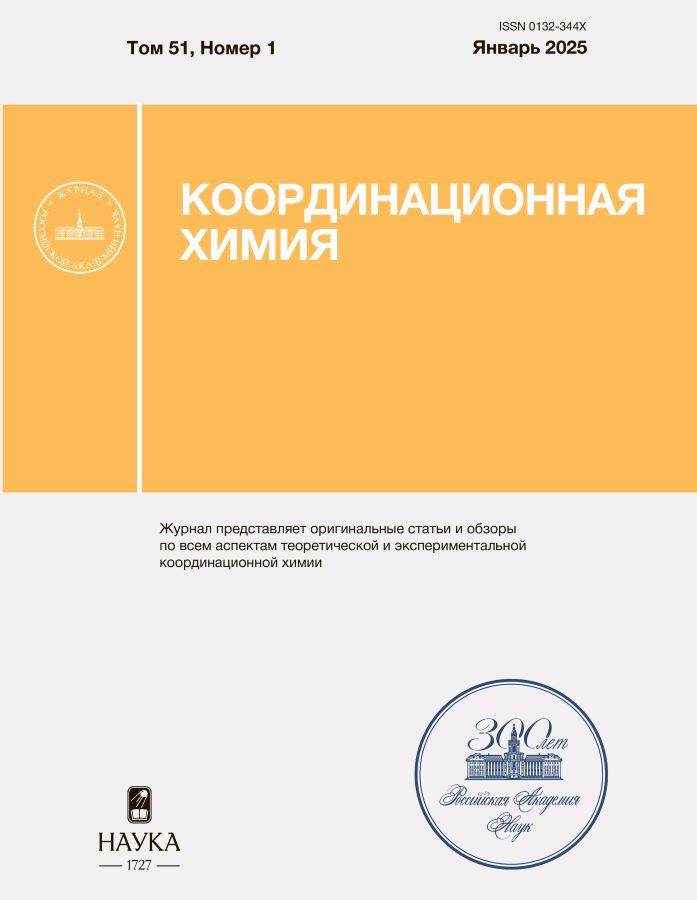卷 51, 编号 1 (2025)
Articles
Nickel(II) Complex with the Bis(phenolate) Pincer N-Heterocyclic Carbene Ligand: Synthesis, Structure, and Properties
摘要
The nickel(II) complex Ni(L)Py (I) (L is 1,3-bis(3,5-di-tert-butyl-2-phenolato)-5,5-dimethyl-(4,6-dihydropyrimidin-2-ylidene)) containing the dianionic bonded N-heterocyclic carbene (NHC) bis(phenolate) ligand is synthesized. In the presence of a stronger base (4-dimethylaminopyridine (DMAP)), the exchange reaction occurs with the replacement of pyridine in complex I by the DMAP molecule to form complex Ni(L)(DMAP) (II), the crystal structure of which is determined by XRD. The synthesized compounds are characterized by elemental analysis, mass spectrometry, and NMR spectroscopy. The spectral characteristics of the compounds are studied.
Koordinacionnaâ himiâ. 2025;51(1):3-11
 3-11
3-11


1D Polymeric Iodoantimonates(III) with 1-Methylpyridinium and 3-Bromo-1-methylpyridinium Cations: Structures and Properties
摘要
The reactions of SbI3 with iodides of cations of the pyridinium family in a mixture of acetonitrile and acetone afford two polymeric iodoantimonate complexes: (1-MePy)[SbI4] (I) and (3-Br-1-MePy)[SbI4] (II). Specific features of the crystal structures are determined by X-ray diffraction (XRD). The thermal stability of compounds I and II is evaluated by thermogravimetry. The optical forbidden bandgaps are estimated from the diffuse reflectance spectra.
Koordinacionnaâ himiâ. 2025;51(1):12-19
 12-19
12-19


Stabilization of an Aqueous Solution of a Liquid Micro Fertilizer Containing Trilon B as a Chelating Agent. Structure of the Molecular Crystal of Sodium Carbamide Ethylenediaminetetraacetate Hydrate NaH3L1 ⋅ (H2N)2CO ⋅ Н2О
摘要
Chemical analysis methods were used to identify the causes for precipitation and fouling with a gray-green deposit of a vessel for the storage of liquid micro fertilizer consisting of ammonium heptamolybdate, potassium chloride, ammonium vanadate, boric acid, chromium trichloride, sodium selenate, and Trilon B as a chelating ligand. The precipitate represented the crystalline 1 : 1 complex of Trilon B with carbamide NaH3L1 ⋅ (H2N)2CO ⋅ Н2О(H4L1 = ethylenediaminetetraacetic acid). The deposit on the vessel bottom and wall was formed upon transformation of the molybdenum complex Na4(MoO3)2L1 ⋅ 8H2O into insoluble coordination polymer in an acid medium. Neutralization of the solution to pH 6–7 and a decrease in the concentration of Trilon B gave a violet micro fertilizer solution that was stable during storage. The molecular structure of the NaH3L1 ⋅ (H2N)2CO ⋅ Н2О crystal was determined.
Koordinacionnaâ himiâ. 2025;51(1):20-30
 20-30
20-30


Influence of Noncovalent Se∙∙∙Se, N∙∙∙P, and Se∙∙∙H Interactions nn the Structures of 1,4-Bis(phenylselenyl)-3a,6a-diaza-1,4-diphosphapentalene in Crystal and Solution
摘要
The reaction of annelated 1,4-dichloro-3a,6a-diaza-1,4-diphosphapentalene (DDPCl2, I) with 2 equivalents of lithium phenyl selenolate (PhSeLi) results in the substitution of the chlorine atoms by the PhSe group and formation of exclusively cis isomer of annelated 1,4-bis(phenylselenyl)-3a,6a-diaza-1,4-diphosphapentalene (II) according to the XRD data. The noncovalent Se···Se interaction (3.968 Е) is observed in the crystal of compound II. The cis-II isomer is by 6.0 kcal/mol thermodynamically more favorable than trans-I according to the DFT/B3LYP/6-31G(d) calculations. The cis-1,4-bis(phenylselenyl) and 1,1-bis(phenylselenyl) isomers (the latter is formed due to the easy migration of the PhSe group) are equilibrated in the solution. Noncovalent N∙∙∙P and Se∙∙∙H interactions participate in the stabilization of the 1,1-isomer. The crystallographic structural information is available at the Cambridge Crystallographic Data Centre (CIF file CCDC no. 2357640).
Koordinacionnaâ himiâ. 2025;51(1):32-40
 32-40
32-40


Fluorine-Containing Polydentate Bis(heterocycles) Based on Di- And Triketone Analogs in the Synthesis of Zinc(II) Complexes
摘要
An approach to the synthesis of polydentate ligands in which the NH-pyrazole cycle is connected by the hydrazone group to the azine fragment (pyridine or pyrimidine) is developed. In the reactions with zinc(II) chloride, the synthesized bis(heterocyclic) compounds act as tridentate ligands with the formation of mononuclear complexes Zn(L)Cl2 (CIF files CCDC nos. 2352630 (I) and 2352631 (II)). The absolute quantum yield (QY = 12%) and fluorescence lifetime (τ = 2.64 ns) are measured for complex II containing the pyridine cycle as the azine fragment.
Koordinacionnaâ himiâ. 2025;51(1):41-50
 41-50
41-50


Coordination Polymers Ca(II)–Cr(III) and Ba(II)–Cr(III) with Cyclobutane-1,1-dicarboxylic Acid Anions
摘要
The reactions of Cr(NO3)3 ⋅ 9H2O with barium and calcium salts of cyclobutane-1,1-dicarboxylic acid (H2Cbdc) in a ratio of 1 : 3 in an aqueous solution are studied. The reaction products isolated in the crystalline state are shown to be compounds formed by the binuclear tetraanionic units Cr2(OH)2(Cbdc)4] 4−, and the nature of the alkaline-earth metal ion introduced into the synthesis affects the dimensionality of the formed polymeric structure. The 2D polymeric compound Ba2Cr2(OH)2(Cbdc)4(H2O)5] ⋅ 3H2O}𝑛 (I) is formed in the reaction with Ba(Cbdc), and the replacement of Ba2+ by Ca2+ results in the formation of the 1D coordination polymer { Ca2Cr2(OH)(Cbdc)4(H2O)6] ⋅ 8H2O}𝑛 (II). The crystal structures of compounds I and II are determined by single-crystal XRD (CIF files CCDC nos. 2344872 (I) and 2344873 (II), respectively).
Koordinacionnaâ himiâ. 2025;51(1):51-59
 51-59
51-59


Synthesis of a New Cobalt Complex with Catechol Dianion and Study of the Kinetics of its Redox-Activated Dissociation
摘要
A new redox-active cobalt(III) complex with a catechol dianion and two 4,4’-dimethoxy-2,2’-bipyridine ligands was synthesized. The reduction of the complex with ascorbic acid in an inert atmosphere was studied by NMR spectroscopy in situ. The reaction followed the first-order kinetics with respect to the starting complex, had a rate constant of 1.1 × 10−3 s−1, and was accompanied by the release of catechol, which served as a model drug.
Koordinacionnaâ himiâ. 2025;51(1):60-71
 60-71
60-71











